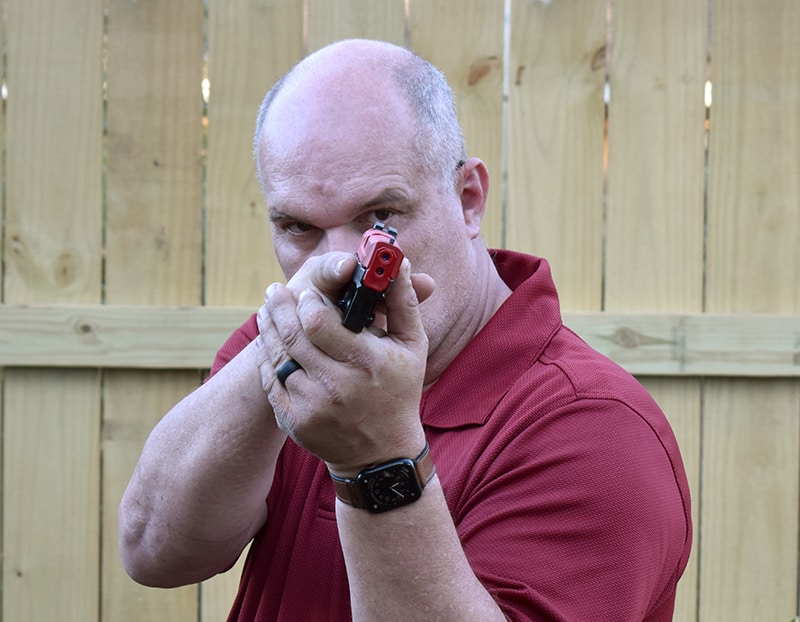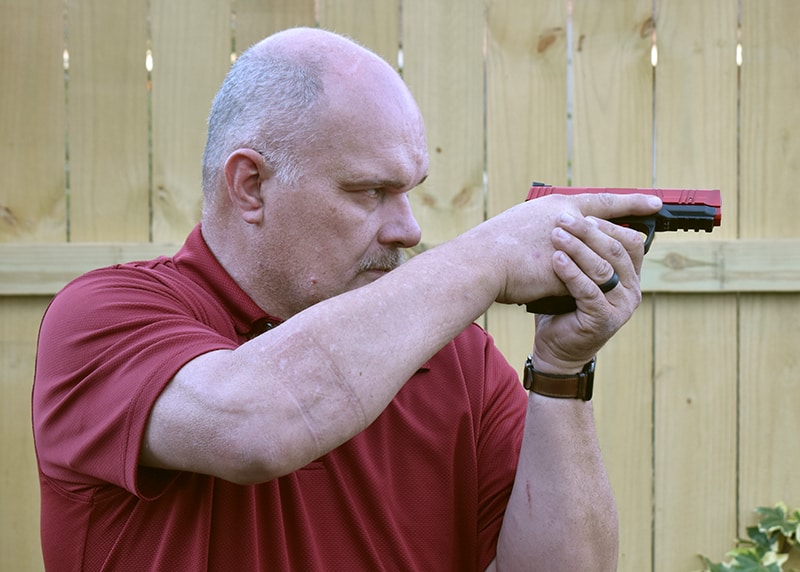What's The C.A.R. System?
Preferred shooting style of John Wick
Throughout the years, I’ve learned many different shooting techniques or styles. I naturally gravitate to a modified Weaver position, mainly because it is the one I used for most of my career as a police officer. If startled, you can bet my automatic response will be to assume a bladed stance with my weak side angled toward perceived danger. As I was taught, stability comes from pushing forward with the strong hand and pulling back with the weak to create locked tension between the two. It provides a reasonably stable platform for accurate shooting. Call me old school, but it’s just what happens naturally for me.
I’ve attended many instructor courses in my time. Almost everyone has advocated that I change to an isosceles shooting position where both my feet and shoulders are square with the target, both arms fully extended and the two-handed grip acts more like a side-to-side clamp rather than the front-to-rear push/pull. Each person claimed this is the “body’s natural response” to danger, but it still seems awkward and unnatural for me. I do shoot isosceles too, but a modified Weaver is automatic. So, I’m always looking for things I can do to build on what works for my natural reactions.
I recently looked into one system that seems to meld with what I’m currently using. It’s called the C.A.R. (Center Axis Relock) System and was created by Paul Castle. Incidentally, Castle passed away in 2011, but left behind a disciple to continuously develop and carry on his program. This man is Jeff Johnsgaard of Natural Tactical Systems. Jeff has continued to develop the system and renamed it the 360º CQD (Close Quarter Defense) Program. I’ve not delved into the CQD Program; I’m more interested in the basics of the C.A.R. System since it works perfectly with my current shooting system.
A Shooting Style You'll Recognize
If you’ve not heard about the C.A.R. System, it’s because it had limited exposure in the U.S., having been only taught to police departments and military units. You’ll recognize it, though. You’ve seen it used in John Wick and other movies. The gun is not fully extended, but is held about 12″ to16″ from the eyes with a noticeable cant of about 30º toward the weak side. The elbow on the weak-side arm points straight down, leaving the lower arm 90º to the strong arm for a very stable shooting platform. This is termed the “Extended” position, and is intended for distances between 5′ and 30′ (where most shootings occur).
The short distance from the eyes provides a profound change in the sight picture. It’s easier to center the front sight in the rear because the rear sight gap appears much wider. The sights are only visible to one eye, so there are no issues between the dominant and non-dominant sides. Castle insisted on using the non-dominant eye and keeping both eyes open. The idea of using the opposite eye to the hand holding the gun was to limit exposure when behind cover when clearing a building. The left or right hand can be used with the opposite eye, depending on which direction you need. Although sighted fire is easier, Castle taught point shooting at close ranges. With the sights close to the eye, it would be indexed shooting rather than actual point shooting. It works very well as taught and is especially suited to shooting from a seated position in a vehicle. I prefer using my dominant eye. Using the non-dominant eye works, but it would require more training time than I believe is worth taking.
30 Degree Cant More Than Hollywood Cool
You might question the 30 degree cant. Trying to hold the pistol upright in this position is unnatural and strains the arm. The cant makes it more natural for the shooter, yet has little effect on accuracy at these short distances.
At closer distances, weapon retention becomes a concern and the position changes to a “High” where the gun is brought back against the chest, pointing to the weak side. It is still gripped with both hands, allowing a more robust hold and the ability to use the body as an effective block against a bad guy’s gun grab. Shooting unsighted from this level seems counterintuitive, yet it is very stable and can provide reasonably accurate and consistent hits on target at contact distances. It’s much safer than the “speed rock” drill that was standard years ago.
C.A.R. is not for everyone, but it perfectly fits my current shooting style. I’m sharing this because it works for me. The biggest surprise I found was the stability when shooting weak-handed — something I’ve struggled with in the past. This is perhaps the only time looking “Hollywood Cool” has helped improve my shooting. Try it on the range. It might work for you too.

Sign up for the Personal Defense newsletter here:





